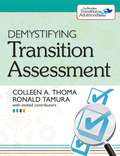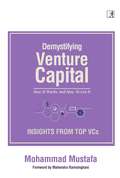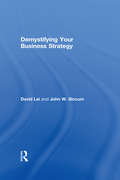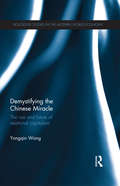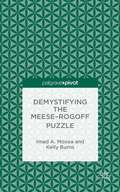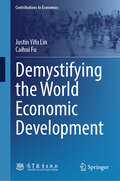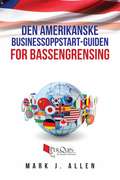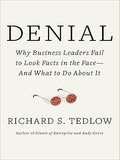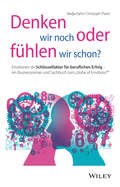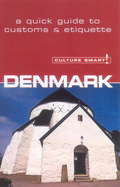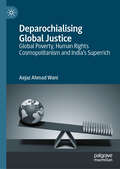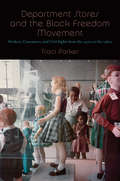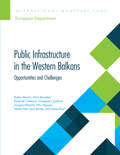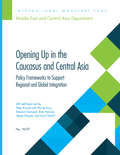- Table View
- List View
Demystifying Theories in Tourism Research
by Holly Donohoe Kelly BrickerIt often seems that there is more confusion than consensus regarding tourism theory. Does tourism have theories it can truly own, or does it just borrow from other academic disciplines? It can be difficult to understand the theories and conceptual frameworks available, and how to apply these ideas to a research endeavour. This book reviews theoretical perspectives on tourism from planning and management, through marketing and host communities to the tourism consumers themselves. Covering issues such as tour guiding, rural tourism development and destination image, it provides a complete guide to the industry. Including pedagogical features throughout, this book is an accessible approach to a controversial subject.
Demystifying Theories in Tourism Research
by Holly Donohoe Professor Kelly BrickerIt often seems that there is more confusion than consensus regarding tourism theory. Does tourism have theories it can truly own, or does it just borrow from other academic disciplines? It can be difficult to understand the theories and conceptual frameworks available, and how to apply these ideas to a research endeavour. This book reviews theoretical perspectives on tourism from planning and management, through marketing and host communities to the tourism consumers themselves. Covering issues such as tour guiding, rural tourism development and destination image, it provides a complete guide to the industry. Including pedagogical features throughout, this book is an accessible approach to a controversial subject.
Demystifying Transition Assessment (The Brookes Transition to Adulthood Series)
by Ronald Tamura Colleen Thoma<p>Assessment is the cornerstone of every good transition plan. Now there's a book that demystifies the what, when, why, and how of collecting transition assessment data-and using the results to help students with disabilities prepare for adulthood. <p>Developed by two respected transition authorities, this practical guide prepares education professionals to use today's best assessment tools and strategies to identify which transition approaches really work. You'll discover how to <p> <li>choose assessments appropriate for each situation and student <li>apply best assessment practices in 7 key areas (see sidebar) <li>collect the right data at the right time <li>implement evidence-based practices that meet IDEA requirements for transition assessment <li>make the most of informal assessments and formal performance-based methods tailored to each student's needs <li>translate assessment results into better, more personalized transition IEP plans</li> <p> <p>To help you find the assessment tools that best meet your needs, the book includes an invaluable quick-reference guide to more than 90 transition assessments and which areas they assess. You'll also follow case studies of a teacher and two students as they navigate the transition assessment process, and you'll get sample forms for assessing student skills and goals, enhancing transition IEPs, helping students plan for college and employment, and much more. <p>Essential for every transition specialist and educator, this book will be your trusted companion as you make sound decisions about assessment; ensure individualized, person-centered transition plans; and support students' post-school goals and dreams.</p>
Demystifying Venture Capital: How It Works and How to Get It
by Mohammad MustafaVenture Capital is a marriage between 'people with money and no ideas' and 'people with ideas and no money'. It is a high-risk investment vehicle with the potential for manifold returns and the possibility of a complete investment written-off. Although it is essentially private money and smaller in size than traditional financing pillars, its impact has been phenomenal, even to the extent of transforming the way we live in the modern world. Yet the fact remains that the business of venture capital is not fully understood by startup founders and fund managers are also not familiar with the inner workings of other venture funds. And, as more public or tax-players&’ money flows into this asset class, it begs a shift from the existing esoteric styles to more transparent and predictable operations. It would also be beneficial if the craft of venture capital is well understood by the business community and most importantly, policymakers as Demystifying Venture Capital: How it works and How to get primarily written to address these concerns, and to explain the subject in a nontechnical manner, as far as possible. A handbook for fund managers, startups, academicians interested in the subject, policy makers, and aspiring entrepreneurs, this book is unique as it has been written along with the top 25 venture funds in India as co-authors. The first part builds the concepts and theoretical framework of venture investing throughout the venture capital life cycle, giving readers a robust academic backdrop while the second part offer 25 first-hand accounts of how VCs invest, where they invest, what they look for while investing, providing invaluable insights into the minds and methods of VCs. All in all, this prototype is a first-of-its-kind endeavour to deliver a 360-degree + view of the Venture Capital universe.
Demystifying Your Business Strategy
by David Lei John W. SlocumWhile scores of strategic management books have been written, many books fail to take into consideration the influences that shape and constrain managers’ ability to formulate and execute well-thought out strategies. Demystifying Your Business Strategy acknowledges and harnesses those influences, providing practitioners with a helpful new approach to developing and maintaining a competitive advantage. In this book, David Lei and John W. Slocum offer readers a comprehensive overview of the drivers of evolutionary advantage, recognizing that sources of competitive advantage for any organization will necessarily shift and evolve in response to changes in the industry environment. Demystifying Your Business Strategy also offers practical insights on how to spot "inflection points" of strategic transition and identify signals that indicate when an organization needs to develop a new source of competitive advantage. With in-depth discussion of the four different types of business strategies that many firms pursue and the strategic disciplines that support them, this book can provide significant insight and direction to managers at all levels within an organization.
Demystifying the Chinese Economy
by Justin Yifu LinChina was the largest and one of most advanced economies in the world before the eighteenth century, yet declined precipitately thereafter and degenerated into one of the world's poorest economies by the late nineteenth century. Despite generations' efforts for national rejuvenation, China did not reverse its fate until it introduced market-oriented reforms in 1979. Since then it has been the most dynamic economy in the world and is likely to regain its position as the world's largest economy before 2030. Based on economic analysis and personal reflection on policy debates, Justin Yifu Lin provides insightful answers to why China was so advanced in premodern times, what caused it to become so poor for almost two centuries, how it grew into a market economy, where its potential is for continuing dynamic growth and what further reforms are needed to complete the transition to a well-functioning, advanced market economy.
Demystifying the Chinese Miracle: The Rise and Future of Relational Capitalism (Routledge Studies In The Modern World Economy)
by Wang YongqinThe last three decades has witnessed miraculous economic growth of China. What has accounted for its miracle? What is the nature and future of the Chinese model? Is it unique? This book presents an analytical framework to demystify China's economic growth miracle. The book suggests that interlinked and relational contracts between the agents (in particular, between the state and the business) can compensate for flawed markets to achieve high growth. This kind of relational capitalism is significant in the investment-based stage of development, when mobilization of resources to exploit the existing technologies is key for growth. The book presents a general theory of interlinked relational contract, the workhorse model of the book. The theory highlights that effective governance is a function of market extent and market completeness. The process of economic development and modernization can be looked at fruitfully from two perspectives: the markets and the institutions and their interactions. The book stresses the critical fit between the development stage and the governance for a country's economic transition and development and thus the idea of "appropriate institutions".
Demystifying the Meese–Rogoff Puzzle
by Imad A. Moosa Kelly BurnsThe authors present compelling evidence, supported by their own measure: the 'adjusted root mean square error', to finally solve the Meese-Rogoff puzzle and provide a new alternative.
Demystifying the World Economic Development (Contributions to Economics)
by Justin Yifu Lin Caihui FuTaking the new structural economics as the theoretical tools, this book obtains the maximum understanding of the history, development, current situation, and trend of the change of world economic structure, as well as China's role in its development and its underlying laws and policies, analyzes the polarization between the rich and poor for countries worldwide, and provides a way for them to achieve common prosperity. The world is going through a new round of major transformation. Profound adjustment has been made in international economy, science, culture, security, and politics, and the international development environment is undergoing profound changes. In this context, this book profoundly and systematically explains the underlying economic transition logic of world development and the general trend of China’s relationship with the world and presents the entire process of world economic development. Readers who pay close attention to the development of the world economy, China's economic development, and China's role in the world economy will find this book very fascinating.
Den Fachkräftemangel im Mittelstand überwinden: Strategien für erfolgreiche Arbeitgeber und wirkungsvolles Employer Branding (essentials)
by Corinna PommereningDieses essential beleuchtet den Umgang mit dem Fachkräftemangel im Mittelstand. Gespräche mit Führungskräften und Experten thematisieren den Status quo, Erfahrungen und Schlüsselaspekte zur Überwindung des Fachkräftemangels. Das Dokument bietet eine praktische Checkliste für eine wirksame Arbeitgeberpositionierung sowie den Employee Life Cycle für ein ganzheitliches Employer Branding. Mit diesen Einblicken und Werkzeugen unterstützt das Buch mittelständische Unternehmen dabei, sich als attraktive Arbeitgeber zu positionieren und den Fachkräftemangel erfolgreich zu bewältigen.
Den amerikanske businessoppstart-guiden for bassengrensing
by Mark J. AllenDenne businessguiden instruerer deg i metodene for å starte og markedsføre en vellykket bedrift. Denne guiden vil vise deg effektive teknikker for å skape en lønnsom rengjøringsvirksomhet selv i disse usikre økonomiske tider. Som et resultat av å lese denne guiden, vil du lære tips og triks for å hjelpe deg med å starte bedriften din med minimal investering. Du lærer hvordan du velger riktig juridisk struktur. Du vil også lære hvilke feil nye bedriftseiere gjør og hvordan du unngår dem! Hvis du er interessert i å tjene mer penger, er dette guiden for deg. I tillegg til tidsbesparende tips, svært effektive markedsføringsideer og forretningshemmeligheter fra innsiden, vil du også få en lett forståelig trinnvis handlingsplan som tar bort den vanlige usikkerheten ved å starte din egen virksomhet. Kom i gang og bli din egen sjef og bestill i dag.
Den of Thieves: The Untold Story Of The Men Who Plundered Wall Street And The Chase That Brought Them Down
by James B. StewartA number-one bestseller from coast to coast, Den of Thieves tells, in masterfully reported detail, the full story of the insider-trading scandal that nearly destroyed Wall Street, the men who pulled it off, and the chase that finally brought them to justice. Pulitzer Prize winner James B. Stewart shows for the first time how four of the biggest names on Wall Street -- Michael Milken, Ivan Boesky, Martin Siegel, and Dennis Levine -- created the greatest insider-trading ring in financial history and almost walked away with billions, until a team of downtrodden detectives triumphed over some of America's most expensive lawyers to bring this powerful quartet to justice.Based on secret grand jury transcripts, interviews, and actual trading records, and containing explosive new revelations about Michael Milken and Ivan Boesky written especially for this paperback edition, Den of Thieves weaves all the facts into an unforgettable narrative -- a portrait of human nature, big business, and crime of unparalleled proportions.
Den schreienden Kollegen kann man nicht wegatmen: Effektives Stressmanagement für Führungskräfte und Mitarbeiter
by Manuela Jacob-NiedballaEs wird endlich Zeit, mit den gängigen "Märchen" über Stress gründlich aufzuräumen: Die Verringerung der Arbeitszeit, häufige Sabbaticals, die sogenannte "Entschleunigung", Achtsamkeitsübungen oder Resilienzstrategien mögen hier und da dem Einzelnen helfen, sind aber stets "subjektiv" und nicht auf die betriebliche Arbeitswelt übertragbar. Zudem versuchen sie, den Menschen zu optimieren, aber sie nehmen nicht die betriebliche Situation in den Blick. Das Buch von Manuela Jacob-Niedballa gibt besonders Führungskräften (aber auch Mitarbeitern) auf die Arbeitssituation in Unternehmen zugeschnittene Methoden und Empfehlungen an die Hand und zeigt, wie sie ihren Verantwortungsbereich stressfreier gestalten. Und zwar ohne dass dafür "mehr" Geld, "mehr" Personal oder "weniger" Arbeitszeit erforderlich wären, denn das wäre in den meisten Betrieben illusorisch. Im Kern geht es darum, sich der vorhandenen, aber oftmals übersehenen Gestaltungsmöglichkeiten bewusst zu werden und sie gezielt zu nutzen, um mehr Selbstbestimmtheit zu erreichen und diese auch den Mitarbeitern zu gewähren. Die Ausführungen der Autorin basieren auf neueren neurowissenschaftlichen und arbeitsmedizinischen Erkenntnissen und Methoden, die in klare und einfache Handlungsmöglichkeiten übersetzt werden.
Denial
by Richard S. Tedlow"Wise. Relevant. Riveting. " -Jim Collins, author of Good to Great Denial is the unconscious belief that a certain fact is too terrible to face and therefore cannot be true. It turns challenges into crises, dilemmas into catastrophes. It's the single greatest obstacle business leaders face. Now Harvard business School professor Richard S. Tedlow tackles two essential questions: Why do so many sane, smart leaders often refuse to accept and act on the facts that threaten their companies and careers? And how do we find the courage to resist denial when facing new trends, changing markets, and tough new competitors? Tedlow highlights strategies the best leaders use to face hard facts and turn challenges into opportunities. His book will help you become one of them. .
Denken wir noch oder fühlen wir schon?: Emotionen als Schlüsselfaktor für beruflichen Erfolg - ein Businessroman und Sachbuch zum "Globe of Emotions"
by Nadja Kahn Christoph TheileMaxi van Weller ist ein ganz normaler Mensch. Mit einem Job, Kollegen, Kolleginnen und ihrem Chef. Von einem Tag auf den anderen bricht ihre bisher heile Welt in der PR-Agentur Clarke zusammen. Das Unternehmen wird verkauft. Vermeintlich nichts Besonderes, denn das passiert jeden Tag in deutschen Unternehmen. Maxi van Weller allerdings lässt den Leser teilhaben an dem, was in ihrem Inneren passiert, denn sie hat zwei Begleiter im Kopf: Ratio und Emotia. Die Leser erfahren durch den inneren Dialog von Ratio & Emotia aus erster Hand, wie Maxi denkt und fühlt sowie mit ihren täglichen Herausforderungen umgeht. Ratio und Emotia begleiten sie durch sämtliche sieben Basis-Emotionen, die Maxi und generell wir Menschen durchleben können und nehmen dabei kein Blatt vor den Mund. Das Buch von Nadja Kahn und Christoph Theile zeigt, dass sowohl Denken als auch Fühlen zusammengehören. Es inspiriert die Leser, Situationen aus dem (unternehmerischen) Alltag zu reflektieren: Denken wir vermeintlich nur oder fühlen wir gerade? Wie spielt beides im unternehmerischen Umfeld zusammen? Durch die spannende Geschichte von Maxi van Weller und ihren beiden Begleitern Ratio & Emotia werden die Leser vom Erkennen zum Verstehen bis hin zum Aktivieren aller Emotionen geführt. Sie erfahren, dass Verstand und Gefühl einander brauchen und Hand in Hand gehen. Abgerundet wird die Story durch einen erläuternden Fachteil, in dem durch den Globe of Emotions®, ein einzigartiges System zur Einordnung der sieben Basis-Emotionen, aufgezeigt wird, dass alle Emotionen ihre Berechtigung in unserem Leben haben. Die fiktiven Textpassagen werden hier aufgegriffen, das emotionale Problem damit gezeigt. Dann folgen eine Situationsbeschreibung sowie eine klare Idee, wie diese Situation mit dem Globe of Emotions besser gelöst werden könnte und auch, was dazu notwendig ist. Nach der Lektüre gehen die Leser gelassener mit Alltagssituationen um und können sich selbst und ihr Gegenüber besser einschätzen. Sie erfahren, dass alle unsere Emotionen ihre Berechtigung haben, auch die vermeintlich negativen, wie etwa Zorn und Ekel.
Denmark - Culture Smart!
by Mark H. SalmonCulture Smart! provides essential information on attitudes, beliefs and behavior in different countries, ensuring that you arrive at your destination aware of basic manners, common courtesies, and sensitive issues. These concise guides tell you what to expect, how to behave, and how to establish a rapport with your hosts. This inside knowledge will enable you to steer clear of embarrassing gaffes and mistakes, feel confident in unfamiliar situations, and develop trust, friendships, and successful business relationships.Culture Smart! offers illuminating insights into the culture and society of a particular country. It will help you to turn your visit-whether on business or for pleasure-into a memorable and enriching experience. Contents include* customs, values, and traditions* historical, religious, and political background* life at home* leisure, social, and cultural life* eating and drinking* dos, don'ts, and taboos* business practices* communication, spoken and unspoken"Culture Smart has come to the rescue of hapless travellers." Sunday Times Travel"... the perfect introduction to the weird, wonderful and downright odd quirks and customs of various countries." Global Travel"...full of fascinating-as well as common-sense-tips to help you avoid embarrassing faux pas." Observer"...as useful as they are entertaining." Easyjet Magazine"...offer glimpses into the psyche of a faraway world." New York Times
Denmark: Financial Sector Assessment Program--Technical Note--Review of Danish Capital Market
by International Monetary FundA report from the International Monetary Fund.
Denmark: Globalization and the Welfare State
by Arthur A. Daemmrich Benjamin KramarzThis case describes how Denmark has balanced the impacts of globalization, including outsourcing and movement of labor with its social welfare offerings. Reforms implemented during the past two decades drove down unemployment, promoted new company formation, and put the country at or near the top of international polls on the ease of doing business. The case describes how Danes forged a consensus that embraced international trade and outsourcing while supporting continuous upgrading of workplace skills. In April 2009, the new Prime Minister, Lars L kke Rasmussen, is balancing short-term responses to a global recession against longer-term planning for the Danish labor market and macroeconomy. Can Denmark keep its borders open to the free movement of goods, services, and labor while also sustaining the breadth of its welfare offerings?
Dennis Hightower and the Walt Disney Co. in Europe
by Todd D. Jick Barbara FeinbergDescribes the initial entry challenges faced by Dennis Hightower after being assigned the task to revitalize and reposition Walt Disney Co. of Europe in preparation for 1992. Allows students to consider the challenges of cultural heterogeneity, Disney traditions, and the culture of local autonomy in each of the European franchises. Students will be asked to develop an action plan for changing the direction and the working relationships in Europe.
Dental Reception and Supervisory Management
by Glenys BridgesDental Reception and Practice Management 2nd Edition is the dental office administrator’s essential companion to all aspects of reception work and supervisory practice management duties. The book covers vital interpersonal skills and the important aspects of business management and marketing relevant to dentistry. In addition, it explains the development of dental care, enhancing the reader’s understanding and awareness of the necessary clinical aspects of dentistry. It also addresses the General Dental Council’s Standards for the Dental Team, which details the nine principals for observing patient rights, and looks at new regulations introduced by the Health and Social Care Act. Provides practical advice for dental receptionists wishing to upgrade their skills Covers all aspects of the receptionist role, from administration and marketing to quality management and patient experience Looks at new standards and regulations put into effect Offers concrete suggestions to improve dental practices and further patient health Includes access to a companion website with case studies and links to useful websites Dental Reception and Practice Management 2nd Edition is designed for use by dental receptionists in practice and for use in dental reception courses. It will also greatly benefit dental nurses, dental hygienists, and dentists.
Denver Museum of Nature & Science
by Jill Avery Jim RosenbergDigital was on Vice President of Strategic Partnerships and Programs Bridget Coughlin's mind these days. DMNS had been dabbling in digital for the past few years, but had never fully committed to it. The time had come to establish a strategic vision, and to decide whether to designate serious human and financial resources. It was time to make some decisions about the DMNS' digital future. The digital discussion was taking place within a larger strategic conversation about the primacy of the onsite experience of the Museum and the need to get outside of its walls to reach new constituents. How should she balance onsite programming, offsite programming, and online programming to maximize attendance and deliver against the Museum's mission? Was digital the magic pill that would allow the Museum to reach new audiences or was DMNS better off delivering a face-to-face museum experience within its own four walls or out on the streets of the Denver community?
Deparochialising Global Justice: Global Poverty, Human Rights Cosmopolitanism and India’s Superrich
by Aejaz Ahmad WaniThis book offers a deparochial account of global justice and addresses disenchantment stemming from its West-centricity and provincial theoretical formulations. As the recurring global poverty debate restricts the duties of alleviating poverty and inequality to the developed world, this book attempts to broaden the spectrum of duties to the superrich of the developing world. Drawing from the case study of India’s superrich as an exemplar of the potent agency of rising powers, the book examines the structural relationship between unbridled affluence and the (un)realisation of the human rights of the poor. It contends that India’s superrich, like their counterparts in other powerful developing countries, both contribute as well as benefit from the highly decentralised global economic order that (re)produces affluence of the few and deprivation of the many within these countries. In doing so, this book argues that the superrich have a positive duty to alleviate poverty and reduce inequality beyond their free-standing moral responsibility for philanthropy.
Department Stores and the Black Freedom Movement: Workers, Consumers, and Civil Rights from the 1930s to the 1980s (The John Hope Franklin Series in African American History and Culture)
by Traci ParkerIn this book, Traci Parker examines the movement to racially integrate white-collar work and consumption in American department stores, and broadens our understanding of historical transformations in African American class and labor formation. Built on the goals, organization, and momentum of earlier struggles for justice, the department store movement channeled the power of store workers and consumers to promote black freedom in the mid-twentieth century. Sponsoring lunch counter sit-ins and protests in the 1950s and 1960s, and challenging discrimination in the courts in the 1970s, this movement ended in the early 1980s with the conclusion of the Sears, Roebuck, and Co. affirmative action cases and the transformation and consolidation of American department stores. In documenting the experiences of African American workers and consumers during this era, Parker highlights the department store as a key site for the inception of a modern black middle class, and demonstrates the ways that both work and consumption were battlegrounds for civil rights.
Departmental Papers / Policy Papers: Economic Progress And Reforms (Departmental Papers / Policy Papers #Departmental Paper No. 08/01)
by International Monetary FundA report from the International Monetary Fund.
Departmental Papers / Policy Papers: Economic Progress And Reforms (Departmental Papers / Policy Papers #Departmental Paper No. 08/01)
by International Monetary FundA report from the International Monetary Fund.

